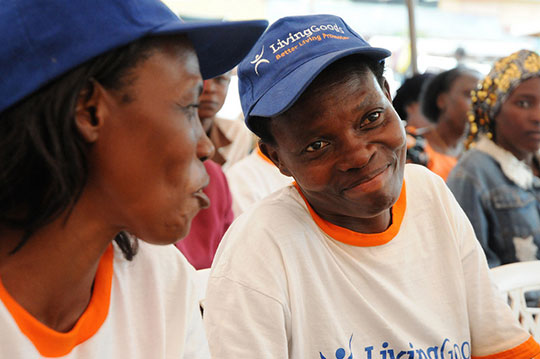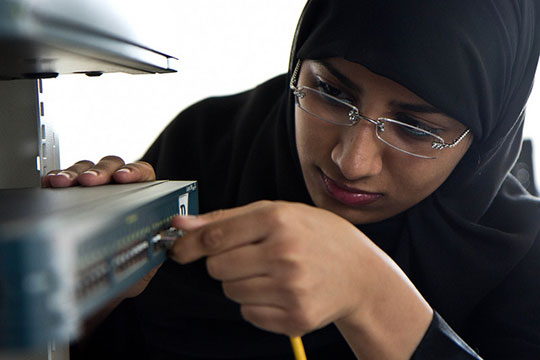As we prepare to celebrate International Women’s Day on March 8, I am reflecting on so many factors that led to where I am today. My mother grew up in India when the path for most women was not one of higher education and a professional life. Yet, with the support of her family, she pursued an advanced degree and became an internationally acclaimed scientist. At a time when arranged marriages were the standard, she met my father and they wed in a non-traditional “love marriage.” With her quiet strength, she was a pioneer, and her experience and outlook helped shape who I am and the path I have taken.
I, too, had the support of my family to pursue dreams of a college degree and professional career, and to be a wife and mother. But many girls and women are not afforded these opportunities, a lack of access which leads to millions trapped in a cycle of poverty, abuse, and poor health—an inherent inequality—where 66 million girls around the world are not in school, 150 million girls are victims of sexual violence each year, and the number 1 cause of death for girls ages 15 to19 is childbirth.
However, we know that educated mothers are more than twice as likely to send their children to school. A child born to a literate mother is 50 percent more likely to survive past the age of 5. Girls with 8 years of education are 4 times less likely to be married as children. One extra year of education can help a girl earn 20 percent more as an adult. What these statistics tell us is clear: When empowered with access to information, resources, and opportunities, girls and women thrive.
Education and Technology: Two Great Equalizers
At Cisco, we support nonprofit organizations that use technology to help underserved people access the information and resources they need to make informed decisions for themselves and their families, and the skills development that helps them get jobs that in turn provide stable and sufficient income. We support girls and women in a variety of ways, and through a number of successful partnerships with nonprofit organizations.
In honor of International Women’s Day, I’d like to celebrate some of our nonprofit partner organizations that empower girls and women to access the same opportunities and choices my mother and I were able to pursue.
Digital Divide Data (DDD) is a nonprofit social enterprise that empowers low-income youth and women with technology-based skills and work experience. Half of the recruits are low-income women, and all are trained to deliver services like data entry, digitization, document conversion, and web research to clients worldwide, via centers in Kenya, Cambodia, and Laos. DDD also provide their employees with scholarships to work toward a college degree, which allows those employees to move on to other, higher paying jobs and which makes space for the next new employees to start their own training.

Masy Sou is a DDD employee in Cambodia. Her father died before she was born, leaving her and her mother to fend for themselves. When her mother became ill and was hospitalized, to earn money Masy bought fruit to sell at the market. “While sitting there, I knew I did not want to be a seller,” she recalled. With the skills, employment, and scholarship programs DDD provides, Masy earned a university degree in accounting and finance. “When I started to work at DDD, everything began to change in my education and my family life,” she said.
Nonprofit Samasource also uses the Internet to bring stable, living-wage work to low income women and youth in Kenya, Uganda, Ghana, India, and Haiti. Samasource recruits and trains workers, enabling them to gain life-changing work skills and experience, and then hires them to provide data entry and content moderation services for paying clients. Half their workers are women.
I met Priscillah at a Samasource delivery center in Kenya. She lives with her parents and has seven siblings, and did not have any formal work experience. Samasource transformed her life, she told me, because she feels productive, is learning new things every day, earns a good salary and is paid regularly. Now the primary breadwinner in her family, she is proud to be a role model to her siblings, particularly her sisters. Her salary helps pay rent and tuition for her siblings, and she is saving the rest to go to college.
Living Goods is an innovative organization leveraging technology to improve the health, wealth, and productivity of people living in poverty. Through an “Avon-like” business model, women micro-entrepreneurs go door-to-door, teaching families how to improve their health and wealth and selling life-changing products like treatments for malaria and diarrhea, fortified foods, safe delivery kits, clean cook stoves, and solar lights. In the process, Living Goods agents significantly improve their own incomes, confidence, and leadership in their communities.
Before joining Living Goods, Sissy Nansubua earned 10,000 shillings (about US$4) a month selling vegetables and tailoring. Sissy’s two boys attend primary school, and fees are 300,000 shillings per year. Her husband’s income didn’t cover the difference, and her boys were often sent home from school. When Sissy learned about Living Goods, she jumped at the chance to earn money to keep her boys in school. Sissy now brings home 67,500 shillings a month from her part-time Living Goods franchise. “I can afford everything we need now, including school fees, clothes, soap, sugar, shoes and a stove. There is such a change in our home.”

Another Cisco partner is the Grameen Foundation, which is investing in products that put women front and center. For example, in Ghana, their Mobile Midwife service provides pregnant women with health information and advice through voice recordings as well as SMS. Grameen developers tested many voices with differing accents and ages, until they found one women felt they could trust and would use.
Women’s World Banking (WWB) is devoted to giving more low-income women access to the financial tools and resources they require to build security and prosperity. WWB works closely with its global network of 39 leading microfinance institutions from 28 countries to create new credit, savings, and insurance products specifically designed for the unique needs of women. With this global reach, they are able to greatly increase the number of women who can build a stronger financial future for themselves and their families.
The Labor Link initiative from Good World Solutions is a mobile technology platform that increases transparency in global supply chains by connecting workers—many of whom are women—directly to the companies that buy their products. Companies like Cisco, HP, Marks & Spencer, and Patagonia use Labor Link to track working conditions in real time, measure livelihoods and social impact, and design programs to support communities and improve working conditions. These corporations can provide workers with access to information on health, financial literacy, and education through their mobile phones, giving them knowledge to make informed decisions for themselves and their families.
“This channel is so important because it gives me a voice to report my opinions and needs to people with the power to make change,” noted one female garment factory worker in Southern India.
Preparing Women for High-Demand Jobs
The Cisco Networking Academy program offers hands-on information and communications technology (ICT) training to prepare students for in-demand careers and globally recognized certifications. As “the world’s largest classroom,” the program provides free online curricula, teacher training, and professional development for instructors to support 9000 academies in 170 countries. Twenty percent of its 1 million students are female. Countries with high female participation include India with 37 percent, Mexico with 31 percent, South Africa with 32 percent, Saudi Arabia with 38 percent, and Turkey with 30 percent.

In some countries, Cisco partners with local agencies to offer the program just for women. For example, in Serbia, the University of Belgrade School of Electrical Engineering and Cisco developed the F_Email Project, a competitive IT training program for a carefully selected group of women who face significant obstacles to employment. By combining the technical skills taught in Cisco Networking Academy courses with soft skills training in a small group setting, the program increases their confidence and prepares them to succeed in the countries’ developing ICT sector.
The all-female Effat University in Saudi Arabia adopted the Cisco Networking Academy curriculum in 2004, and the program has become a training ground for women leaders in Saudi Arabia and changed perceptions about what educational and professional opportunities should be offered to women.
As we celebrate International Women’s Day, let’s celebrate innovative organizations that use technology to improve the health and wealth of women and girls around the world—working to helping them realize their full potential. Let’s hear it for the women and girls!


Excellent piece! Congratulations on a great job well done!
I’m great to see my information on your blog.
Thanks
I love hearing about education programs to enable girls and young women across the globe. Thanks for sharing!
What about men!? Where is the equality?
Today’s typical IT environment is much more sophisticated and women, who have always had the talent, now have the desire to work in it.
When I teach CCNA Routing & Switching classes, it’s my female students who often catch on more quickly, they’ve completed advanced labs before many male students have even grasped the subject!